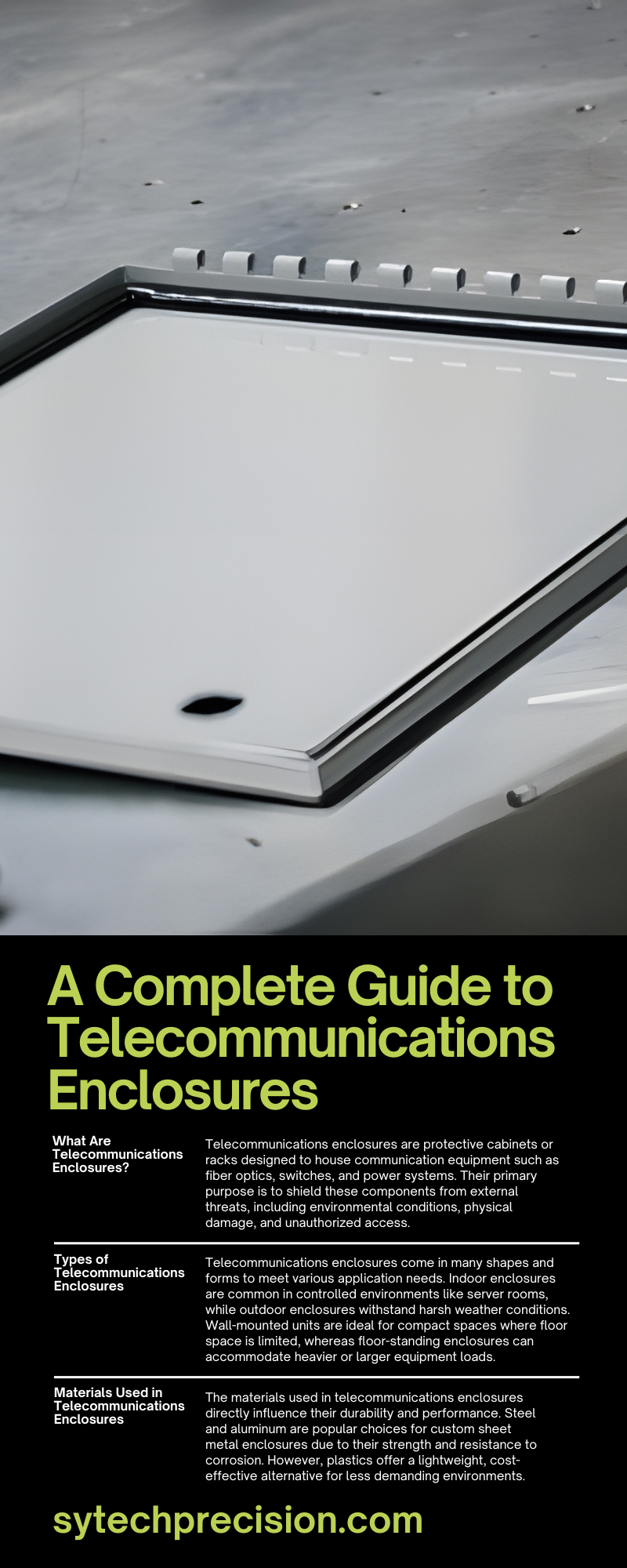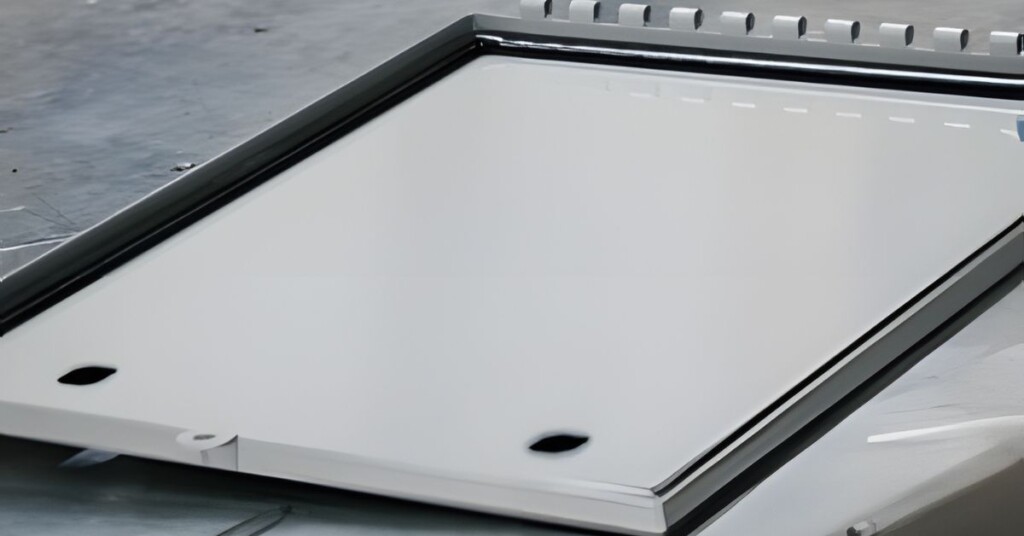Telecommunications enclosures are structures protecting sensitive equipment from environmental factors, ensuring seamless operation in public and private telecom systems. Without them, our increasingly connected world would face disruptions in communication. Use this complete guide to telecommunications enclosures as a comprehensive roadmap to understanding telecommunications enclosures—from their types and materials to design features, installation, and future innovations.
What Are Telecommunications Enclosures?
Telecommunications enclosures are protective cabinets or racks designed to house communication equipment such as fiber optics, switches, and power systems. Their primary purpose is to shield these components from external threats, including environmental conditions, physical damage, and unauthorized access.
Common features of these enclosures include cable entry points, locking mechanisms, and climate control systems to maintain proper equipment functionality. You’ll find them in a variety of applications, such as data centers, outdoor installations, and industrial networks. These enclosures are an indispensable component, ensuring the reliability and longevity of critical communication systems.
Types of Telecommunications Enclosures
Telecommunications enclosures come in many shapes and forms to meet various application needs. Indoor enclosures are common in controlled environments like server rooms, while outdoor enclosures withstand harsh weather conditions. Wall-mounted units are ideal for compact spaces where floor space is limited, whereas floor-standing enclosures can accommodate heavier or larger equipment loads.
Specialty enclosures—such as server racks and pole-mounted units—cater to niche requirements for tailored functionality designed for diverse setups. Each type serves an important role in creating an efficient, secure telecom network.
Materials Used in Telecommunications Enclosures
The materials used in telecommunications enclosures directly influence their durability and performance. Steel and aluminum are popular choices for custom sheet metal enclosures due to their strength and resistance to corrosion. However, plastics offer a lightweight, cost-effective alternative for less demanding environments.
Each material comes with a set of pros and cons; for instance, steel provides superior strength, but it’s more prone to rust if it doesn’t have the proper coating. Environmental factors—such as humidity and temperature—can also affect the material’s suitability. Choosing the right material ensures the enclosure withstands its operating environment over the long term.
Design Considerations
Effective design features are critical to the success of any telecommunications enclosure. Thermal management and ventilation systems—like fans or heat exchangers—prevent overheating and facilitate smooth operation. Cable management solutions—including neatly routed brackets and trays—simplify wiring organization and maintenance.
Accessibility and security are also paramount. Lockable doors and adjustable shelving protect against unauthorized access while accommodating diverse equipment.
Customization options—such as modular frames and tailored sizes—provide additional flexibility to meet unique project requirements. As previously mentioned, the materials determine the longevity and durability of the enclosure by providing safety from environmental factors and security from theft.
Installation Guidelines
Proper installation of telecommunications enclosures is essential to their performance and longevity. Select an appropriate site that meets environmental and logistical needs, whether indoors or outdoors. Preparing the space involves guaranteeing it is level, secure, and capable of supporting the load of the enclosure and equipment.
Installation professionals should follow step-by-step instructions, including the safe integration of cables, hardware, and any cooling systems. Common challenges, like uneven floors or limited access to power, are solvable with thoughtful planning and simple adjustments.
Environmental Protection and Sealing
Telecommunications enclosures must provide robust environmental protection to maintain a consistent internal climate. The use of ingress protection (IP) and National Electrical Manufacturers Association (NEMA) ratings ensures enclosures safeguard equipment from dust, water, and extreme temperatures. These ratings quantify the degree of protection against specific environmental hazards, such as rain, snow, and debris intrusion.
High-quality sealing—including rubber gaskets and weatherproof materials—provides a tight, durable barrier. Consider the materials used, such as sheet metal, to make sure the enclosure is safe and sustainable. Additionally, compliance with local and international environmental regulations helps maintain operational reliability and safety.
Electrical and Power Integration
Power management is a vital consideration in telecommunications enclosures. Built-in power distribution units (PDUs) facilitate an even power supply across all connected devices, preventing overloads. Proper grounding and bonding maintain employee safety and prevent malfunctions caused by electrical surges.
Redundant power systems and backup solutions, like uninterruptible power supplies (UPS), provide critical reliability in the event of power outages. Structured electrical integration provides safety and efficiency to support the seamless operation of telecom infrastructure under any circumstances. Combine these electrical integrations with cable management to house all devices in the enclosure with uninterrupted connections, assisting in areas such as IT centers.
Cooling and Ventilation Systems
Effective cooling and ventilation systems are necessary to prevent equipment from overheating inside telecommunications enclosures. Passive systems rely on natural airflow, while active solutions, like fans or cooling units, provide additional temperature regulation. For high-demand environments, liquid cooling offers advanced thermal efficiency.
Proper design ensures good air circulation, minimizing hotspots and optimizing energy use. Reliable cooling solutions extend the functional lifespan of telecom equipment, enabling it to operate efficiently even under demanding conditions.
Maintenance and Inspection Practices
Routine maintenance keeps telecommunications enclosures in peak condition. A regular inspection schedule should include checking for corrosion, examining wiring integrity, and testing climate control systems.
Common issues—like misaligned doors or damaged seals—need prompt addressing to prevent further complications. Maintenance extends the useful life of enclosures and reduces overall operational costs. Keep detailed records of maintenance efforts for quicker diagnosis and resolution of future challenges.
Industry Standards and Certifications
Adhering to industry standards ensures telecommunications enclosures meet performance and safety requirements. Certifications such as ISO, IEC, and NEMA confirm products meet globally recognized benchmarks for quality and reliability.
Compliance with regulatory requirements is crucial in sectors such as health care and transportation. When evaluating enclosures, always look for certifications that align with your specific operational needs to ensure they meet thorough industry standards.
Common Challenges and How To Address Them
Some telecommunication enclosure challenges include space constraints and environmental extremes. Efficient designs—like compact units or modular systems—mitigate space issues in tight setups. Additionally, protective coatings and high-quality seals increase the durability of enclosures in extreme conditions.
Deter vandalism and unauthorized access with reinforced structures and advanced locking systems. Addressing these challenges ensures that your investment remains secure and functional.
Telecommunications enclosures are vital to the function and security of modern communication systems. From robust materials to advanced cooling systems, their design can make or break an operation.
Make the choices that best suit your telecom infrastructure. Use this guide to telecommunication enclosures for an operational storage solution. Prioritizing quality and compliance ensures short-term efficiency and long-term reliability, securing the backbone of our connected world.

